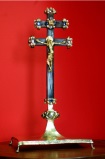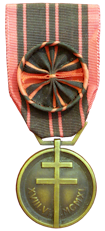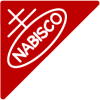Cross of Lorraine
also known as the Gaullist Cross
The Lorraine Cross is a Latin Cross with an upper bar (titulus) and usually without a corpus.
In heraldry, the Lorraine Cross is a localised (French) form of Patriarchal Cross. Its popularity has spread worldwide and is known by various names, depending on the local language and use. In Spain, for example, it is called the Cruz de Lorena, and in Hungary as Szent István Kereszt (St. Stephen's Cross).
Early crosses were similar to the diesis with two horizontal beams of equal length. The upper beam was as close to the top as the lower beam was to the bottom.
Origin
Over a thousand years ago, the King Lothaire gave his name to a province in the northeast of France. The name 'Lothaire' evolved over the years to 'Lorraine'. The region has shrunk and now borders with Belgium, Luxemburg and Germany. So that's where 'Lorraine' comes from.
For this particular cross design, we must go back much further.
One of the earliest uses was in Samaria (now Jordan) as an ideogram for rulership, since it depicted a shepherd's crook. This was adopted for use as a Patriarchal Cross, the emblem of an archbishop, and became the arms of the Patriarch of Jerusalem, who granted its use by the Knights Templar to wear in addition to their Cross Pattée.
Alex Roman tells us that...
Pope Eugene III granted them the Cross of Lorraine and made them answerable to the pope alone (Pope Eugene III was also a disciple of St. Bernard of Clairvaux who founded the Templars at the Council of Troyes, northeastern France, in the 12th century).
The two-tiered Cross signified higher authority, Metropolitanical and Patriarchal. That it was granted to a religious Order of Knights was quite remarkable. On their flags and shields, the Templar two-tiered Cross would have simply been two horizontal bars of equal lengthy going from end to end. However, the particular two-tiered Cross the Templars bore, as indicated by those the commanders wore around their necks (and which Templar orders today wear such as the Sovereign Military Order of the Temple of Jerusalem), show that the second tier was not above the main 'arm-bar' of the Cross, but below which is where the feet of Christ would have been nailed, the 'sub-padenum'. (foot-rest) that is prominent in Eastern Crosses, especially the Russian Orthodox Calvary Cross.
The sub-padenum is a reference to the words of Psalm 99 (Septuagint version) "Exalt ye the Lord our God, and worship the foot-stool of His feet, for He is holy." (verse 5).
For the Templars, the red cross represented at once their mission to protect the pilgrims to the Holy Sepulchre in Jerusalem and self-sacrifice in imitation of the One crucified on it. A number of their grand masters had the Church of the Holy Sepulchre on their coats of arms or seals and this also represented for them the 'Temple of Jerusalem' (prefigured in the Old Testament by the Temple of Solomon near where they had their HQ).
Their beauceant Templar banner with the red cross was holy to them and they always posted a guard of ten soldiers around it at all times. When it was unfurled before a battle, it struck fear in their enemies and the Templars would not leave the battlefield for as long as their cross-flag flew above them. At the Battle of Hattin, 80 captured Templars were led to a cross or to their cross-flag and were told to spit at it. When they didn't, they were beheaded and so it was with the entire number of Templars then and after other battles.
The Duke of Lorraine, Godefroy de Boullion, used this cross for his standard when he took part in the capture of Jerusalem. The heraldry was then passed on to his successors.
In the 15th century, the Duke of Anjou inherited it after the Battle of Nancy, following the defeat of Charles the Bold, Duke of Burgundy.
This did not, however, give rise to the design's alternative name Anjou Cross. The Croix d' Anjou (photo on the right) had already been fashioned by the goldsmiths of Charles V (1338–1380) as a reliquary to house a piece of the Cross of Christ brought back from the Holy Land in 1244. By 1379 the design had been adopted as the emblem of the Duchy of Lorraine under René of Anjou.
The Lorraine region, because of its location, has hosted many wars and battles. Twice it was annexed by Germany and when Hitler took control of the region in WWII, General de Gaulle chose the Croix de Lorraine as a symbol of resistance against Germany's advance.
There were several French Resistance groups, and de Gaulle's was called the Forces Francaises Libres. The cross then also became known as the Free French Cross, the de Gaulle Cross or the Gaullist Cross.
In WWI also, there had been much fighting in the area. On 15 September 1918 in a heavily bombed township in Lorraine, an orphaned five-day old German Shepherd puppy was rescued. The dog later became the famous star of Warner movies and known as the brave 'Rin Tin Tin', man's best friend.
It is said the only life Rin Tin Tin actually saved was that of Warner Bros. which was facing bankruptcy. But there's no doubt the canine film star helped promote the idea that our four-legged friends would risk their lives to save their two-legged masters (see Purple Cross Award). For this, he was world famous over several generations.
Medicine
But on the infamous side, Lorraine saw the extensive use of poison gas to choke soldiers to death.
Slightly prior to WWI, in 1902, doctors met in Berlin at the International Tuberculosis Congress and delegates decided that because tuberculosis was so rampant they should declare war on this devastating disease.
For this 'war' it was appropriate to have a 'battle standard'. The representative from Lorraine suggested that they should take as a symbol the doubled-barred Red Cross of Lorraine, since many medieval victories for the French in battle fields were attributed to carrying this red cross into the fight.
Today the French-based International Union Against Tuberculosis (IUATLD) has branches in over 100 countries – all identified by the Cross of Lorraine. (See Medical Crosses for more about this double-barred red cross.)
Poison gas in WWI killed over 90,000 soldiers. A dreadful waste of young lives, and yet today, governments around the world prepare for their own future battles against economic competitors by building new and more effective chemical and biological weapons. Purely for defence, of course. (See Black Death Cross and Crenel Cross.)
Hungary and Slovakia
Many national flags include a Christian cross in their design.
Hungary's coat-of-arms, for example, is a tricolour red, white and green (meaning strength, fidelity and hope, respectively). The emblem includes a white double-barred cross, known as the St. Stephen's Cross and named after the first King of Hungary who later became Hungary's patron saint.
For a long time, neighbouring Slovakia was part of the Hungarian kingdom and their current national flag features the same white double-barred cross.
In both countries, the symbol has been incorporated (or hijacked, if you prefer) into the emblems of far-right political parties such as Jobbik, Slovenská Národná Strana, and Ĺudová Strana – Naše Slovensko.
Nationalist parties

Jobbik emblem
We're not going to discuss the merits or demerits of Jobbik, the "Movement for a Better Hungary ... a principled, conservative and radically patriotic Christian party". Their website shows their Hungarian pride and passion for changing the Hungarian nation to be a country for qualifying Hungarian nationals only, and not the unwelcome immigrants, especially Roma and Jewish.

Slovenská Národná Strana

Ĺudová Strana – Naše Slovensko
Across the border in Slovakia we find Slovenská Národná Strana (Slovakian National Party) and Ĺudová Strana Naše Slovensko (People's Party-Our Slovakia).
Just as the Nazi party used the Swastika Cross, central to the Hungarian and Slovakian party logos is the Christian cross of St. Stephen. This is a curious choice of today's parties because as noted above, not only was this double-barred cross used by the fighters against Nazism in WWII, but also because Jesus (who was Jewish, incidentally) has no interest in nationalism, race or ethnicity.
A portate version appears in various commercial logos, but their similarity with the Lorraine is coincidental. There is no intention by the companies to imply their logo includes a cross. One exception is the logo used by Nabisco. (See the Oreo Cross)
In most churches, 'Patriarch' is the title of a bishop who has a higher juridical rank.
The more popular, but arguably incorrect, spelling is "suppedaneum". There is more about this on the Suppedaneum Cross page.
Spartacus estimates 91,198 were killed spartacus.schoolnet.co.uk
Based on the Italian tricolour, rotated 90°.
https://www.jobbik.com/short_summary_about_jobbik













